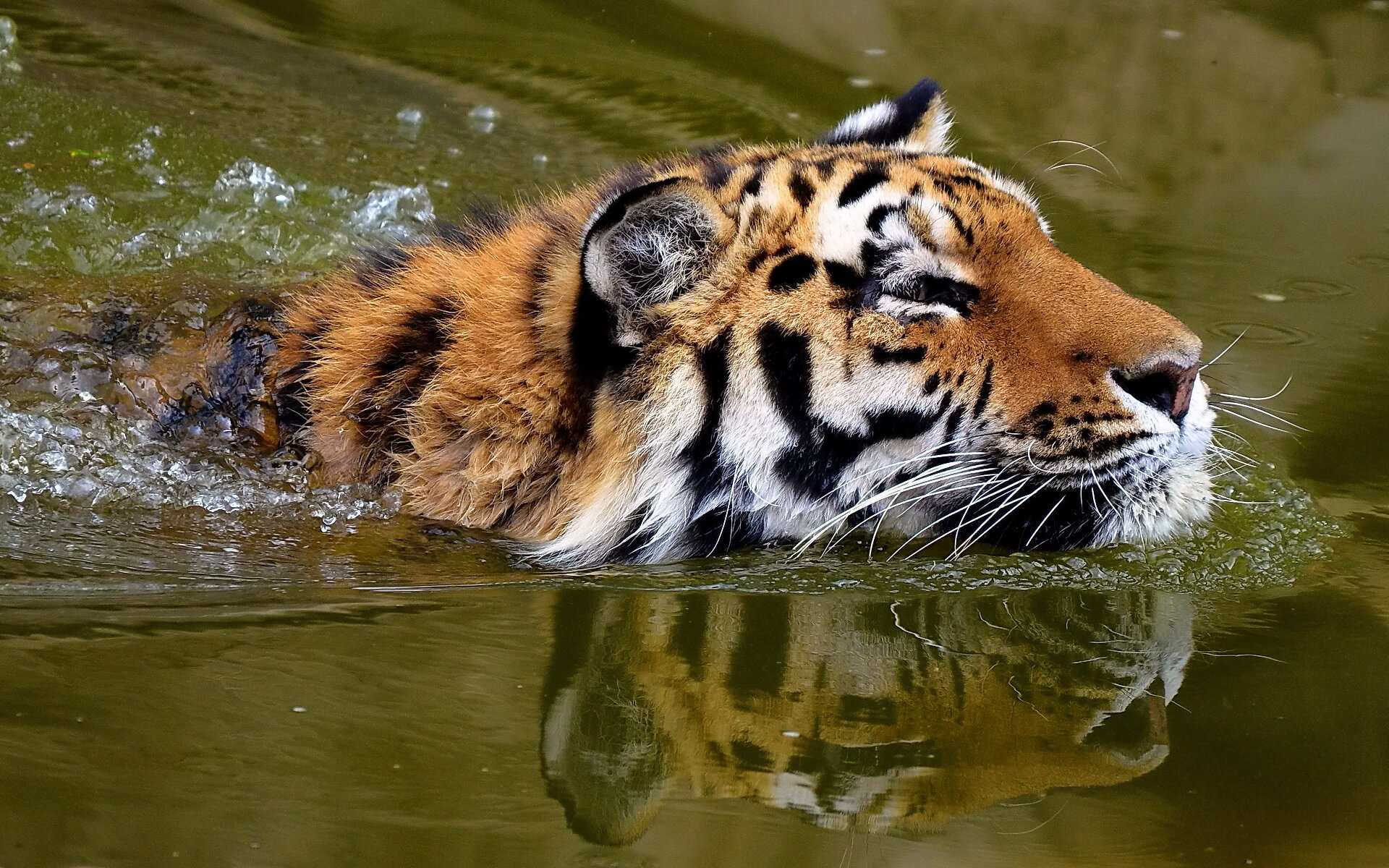
Tigers are incredible creatures that captivate our imagination with their beauty, strength, and agility. While we often think of them as fierce land predators, did you know that tigers are also excellent swimmers? Yes, that’s right! Tigers are highly skilled swimmers and are known to spend a significant amount of time in water.
In this article, we will dive into the fascinating world of tiger swimming and explore 20 interesting facts about these magnificent animals in the water. From their natural habitats to their swimming techniques, we will uncover a variety of intriguing information that showcases the incredible adaptability and versatility of tigers.
So, get ready to be amazed as we delve into the aquatic adventures of tigers and discover some astonishing facts that highlight their exceptional prowess in swimming.
Key Takeaways:
- Tigers are natural swimmers and can swim for long distances, using their powerful paws and streamlined bodies to hunt, play, and relax in water.
- From marking territory to escaping danger, tigers’ swimming skills showcase their adaptability and prowess, making them truly remarkable in the animal kingdom.
The Adaptations for Swimming
Tigers have a range of physical adaptations that enable them to be excellent swimmers. Their muscular bodies, strong forelimbs, and webbed toes allow for efficient movement through water. Their large, powerful paws act like paddles as they gracefully glide through lakes and rivers, making them formidable aquatic hunters.
Tigers Can Swim for Long Distances
Unlike most other big cats, tigers are not just occasional swimmers; they can swim for long distances. They can move effortlessly through water for up to three miles at a time, exhibiting both strength and endurance.
Tigers are Natural Swimmers
From a young age, tigers show a natural affinity for water. Even tiger cubs are introduced to swimming by their mothers, who gently guide them into the water. This early exposure helps them develop their swimming skills and build confidence in the water.
Tigers are Stealthy Underwater
When tigers swim, they can stealthily move underwater, using their streamlined bodies to their advantage. Natural camouflaging stripes help them blend into the surrounding environment, allowing them to approach their prey undetected.
Tigers Swim to Hunt
Tigers are not just recreational swimmers; they often swim to hunt. Their ability to silently glide through water gives them an advantage when ambushing prey. They can swim up to their necks in water, silently awaiting the perfect moment to make their move.
Tigers Have Excellent Night Vision
As nocturnal hunters, tigers are equipped with outstanding night vision. This ability, combined with their swimming skills, allows them to stealthily navigate through bodies of water in the dark, increasing their chances of a successful hunt.
Tigers Love to Cool Off in Water
Like domestic cats, tigers enjoy cooling off in water, especially during hot weather. Taking a dip in a pond or river provides them with relief from the scorching heat and helps regulate their body temperature.
Tigers Swim to Territory Mark
Tigers are known to mark their territories using scent glands located on their tail. Swimming allows them to mark their territory along the water’s edge, leaving behind their distinctive scent for other tigers to notice.
Tigers are Powerful Swimmers
Tigers are incredibly powerful swimmers, thanks to their strong muscles and powerful strokes. They can easily navigate through currents and swim against the flow of rivers, showcasing their remarkable physical abilities.
Tigers Display Playful Behavior in Water
When tigers encounter water, they often display playful behavior. They can be seen splashing around, chasing each other, or simply enjoying the sensation of being in the water. It’s a sight that showcases their playful and curious nature.
Tigers Swim to Escape Danger
In the wild, tigers may encounter danger from predators or disturbances caused by humans. Swimming provides them with an escape route, as they can quickly disappear into the safety of the water and swim away from potential threats.
Tigers Swim to Find Mate
Swimming also plays a role in the tiger’s mating rituals. Female tigers, when in heat, will often swim to attract males and mark their territories during this time. Swimming becomes an essential part of their courtship behavior.
Tigers are Expert Divers
Tigers are not only skilled swimmers but also expert divers. They can plunge into water, diving underwater to catch fish or ambush prey. Their ability to hold their breath for a considerable amount of time enables them to execute successful underwater attacks.
Tigers are Efficient at Crossing Water Bodies
In the wild, tigers frequently encounter water bodies such as streams or small rivers. Their adept swimming skills allow them to effortlessly cross these obstacles, expanding their hunting grounds and territory.
Tigers can Swim in a Variety of Habitats
Tigers are incredibly adaptable and can swim in various habitat types. Whether it’s the mangroves, swamps, or dense rainforests, these majestic cats can navigate through different aquatic environments with ease.
Tigers Follow Prey into Water
Tigers are known to follow their prey into water bodies. Whether it be deer, wild boars, or even birds, tigers use their swimming prowess to chase down their quarry, utilizing their aquatic advantage to secure a meal.
Tigers Swim for Recreation
While swimming is essential for survival and hunting, tigers also swim for leisure. It serves as a form of exercise and entertainment, allowing them to engage in a playful activity that keeps them stimulated and content.
Tigers Can Tolerate Saltwater
Tigers have been observed swimming in saltwater environments. Although they do not dwell in marine habitats, they have the ability to withstand brief exposure to saltwater and can swim across narrow channels or coastal areas if the need arises.
Tigers are Excellent Swimmers from Birth
Tiger cubs are born with natural swimming instincts. They can paddle and move around in water even before they can walk on land. It demonstrates their innate abilities and sets the foundation for their future swimming prowess.
Tigers Swim to Relax
Just like humans enjoy a soothing swim to unwind, tigers also use water as a means of relaxation. Immersing themselves in calm waters allows them to destress and find tranquility in their surroundings.
These 20 Tiger Swimming Facts highlight the incredible adaptability and prowess of these majestic creatures in water. Tigers are not only powerful on land but also excel in the aquatic realm, making them truly remarkable beings in the animal kingdom.
Conclusion
In conclusion, tigers are truly magnificent creatures both on land and in the water. Their ability to swim with such grace and agility is just one of the many fascinating facts about them. From their adaptive behavior in different habitats to their strong swimming skills, these apex predators continue to captivate our imaginations.Tigers are not only renowned for their powerful swimming abilities but also for their incredible strength, agility, and unmatched beauty. Throughout history, they have inspired awe and admiration, being symbols of courage and resilience. As we continue to learn more about these incredible animals, let us never forget the importance of preserving their natural habitats and protecting them from the threats they face.By raising awareness about tiger conservation and supporting conservation efforts, we can ensure the survival of these magnificent creatures for future generations to admire and cherish.
FAQs
1. Can tigers swim?
Yes, tigers are excellent swimmers. They are known to swim across rivers, lakes, and even the open sea, with ease and grace.
2. Why do tigers swim?
Tigers swim for various reasons. Swimming allows them to cool off in hot weather, traverse water bodies in search of prey, and even to escape from potential threats.
3. How fast can tigers swim?
Tigers can swim at speeds of up to 6 miles per hour (10 kilometers per hour), making them efficient and powerful in water.
4. Are all tigers good swimmers?
While not all tigers may have the same level of proficiency in swimming, most tigers have the inherent ability to swim and adapt to aquatic environments.
5. Can tigers swim long distances?
Yes, tigers are capable of swimming long distances, especially when hunting or in search of new territories. They have been known to swim distances of up to 3 miles (5 kilometers).
6. Do tigers enjoy swimming?
Many tigers seem to enjoy swimming, especially when playing or cooling off in water bodies. It is not uncommon to witness tigers frolicking and splashing in ponds or rivers.
7. Are there any other big cats that swim?
Yes, other big cats like jaguars and leopards are also known to be excellent swimmers. They share similar swimming abilities and habits with tigers.
8. Can tigers swim underwater?
Tigers are capable of swimming underwater for short distances, but they are not like marine mammals that spend extended periods underwater.
9. Do tigers hunt in water?
Tigers are known to ambush their prey from the water’s edge, utilizing their swimming abilities to their advantage. They may stalk prey in water or lay in wait before launching an attack.
10. Are there any risks for tigers when swimming?
While tigers are skilled swimmers, they do face certain risks when swimming in the wild, such as encountering larger predators or strong river currents.
Was this page helpful?
Our commitment to delivering trustworthy and engaging content is at the heart of what we do. Each fact on our site is contributed by real users like you, bringing a wealth of diverse insights and information. To ensure the highest standards of accuracy and reliability, our dedicated editors meticulously review each submission. This process guarantees that the facts we share are not only fascinating but also credible. Trust in our commitment to quality and authenticity as you explore and learn with us.


